Introducing the Radeon X1650 XT: A New Mainstream GPU from ATI
by Josh Venning on October 30, 2006 6:00 AM EST- Posted in
- GPUs
CrossFire Performance
The X1650 XT is the second card with the new ATI CrossFire features. With the X1950 Pro, ATI got rid of the annoying dongle connector for good, and they have adopted a very NVIDIA-like approach, with small bridge connections on the top of the cards for CrossFire operation. We think this was a wise choice for ATI and applaud them for it.
We were curious what kind of CrossFire performance we would see with the Radeon X1650 XT, particularly in comparison with the GeForce 7600 GT in SLI mode. Again, since the 7600 GT is the X1650 XT's main competitor, how these cards perform in CrossFire and SLI was something we wanted to take a look at. We've also included some other cards for reference, and we've chosen a few of the same tests from our performance section for comparison.
CrossFire Performance Battlefield 2
The first test is in Battlefield 2 with 4X AA enabled.
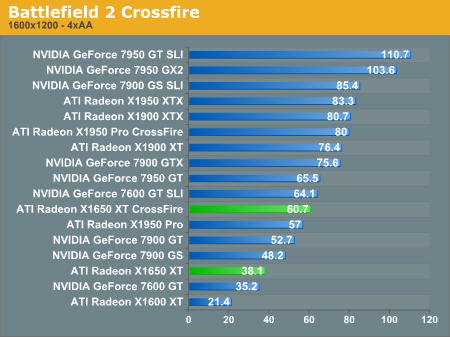

In Battlefield 2, we see that with CrossFire we get a 55%-59% improvement in frame rate with the X1650 XT over single card operation. The performance of two of these cards in CrossFire (in this game) is comparable to a single X1950 Pro (or a 7900 GT or 7950 GT on the NVIDIA side). We can also see that the 7600 GT SLI gets slightly better performance than the X1650 XT in each of the resolutions. This is something we've seen in the past: in many instances, SLI provides better performance scaling than CrossFire. Here the 7600 GT SLI configuration performs 80%-90% better. Hopefully ATI can improve the efficiency of CrossFire more in the future.
CrossFire Performance Oblivion
For our Oblivion CrossFire tests, we again used 1024x768, 1280x1024, and 1600x1200, omitting 1920x1440 because most cards can't run the game at this resolution.
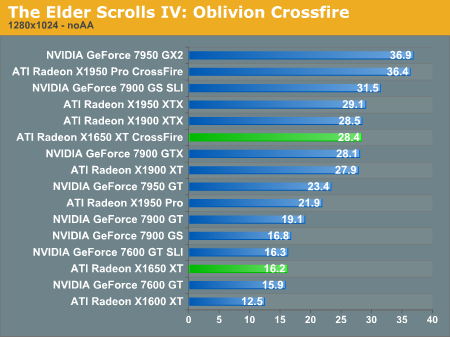
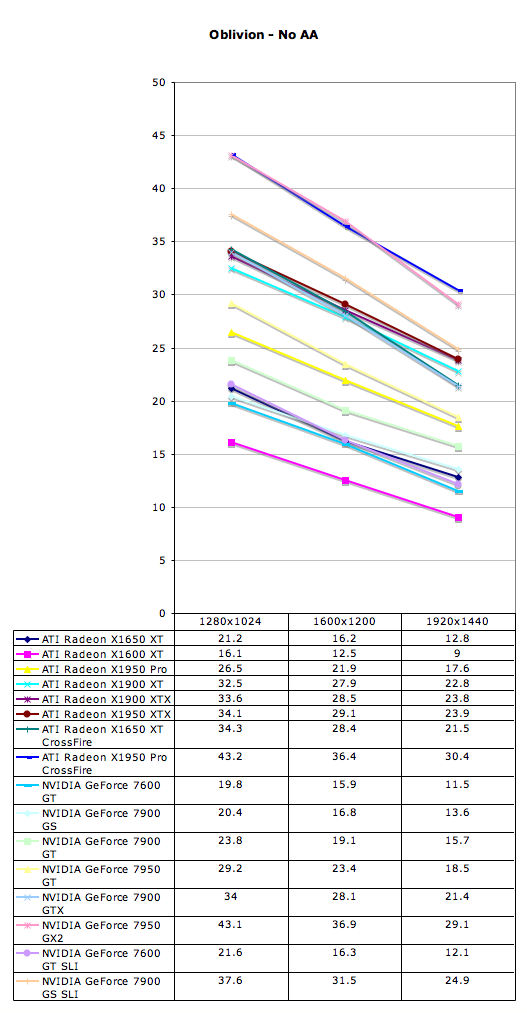
We noticed an issue during our Oblivion SLI and CrossFire tests with the 7600 GT in SLI mode. There appears to be only a very tiny increase in performance when running two of these cards in SLI mode over a single 7600 GT. We aren't exactly sure why this is, but Oblivion is definitely a very graphically demanding game, and ATI hardware tends to perform better with this game. This fact is very evident when we look at the kind of increase we see in performance on the graph above with the X1650 XT in CrossFire mode over a single card. At 1600x1200 we see about a 68% increase in performance with the CrossFire X1650 XT setup over the single X1650 XT. Having two of these cards in CrossFire mode will definitely allow you to crank up the settings in the game more, if you plan to go that route.
For now, we would disregard 7600 GT SLI performance in Oblivion as there appears to be a driver glitch at play. 7900 GS SLI scores 83%-88% higher than a single 7900 GS, so the <10% improvement seen on the 7600 GT SLI cards is clearly incorrect. We are investigating the matter further. X1650 XT will likely fall slightly behind 7600 GT SLI if we see a similar SLI improvement, however, as CrossFire only improves X1650 XT performance 62%-75% and the single X1650 XT is basically tied with a single 7600 GT.
CrossFire Performance Half-Life 2 Episode one
Lastly, we looked at Half-Life 2 Episode one with 4xaa enabled.
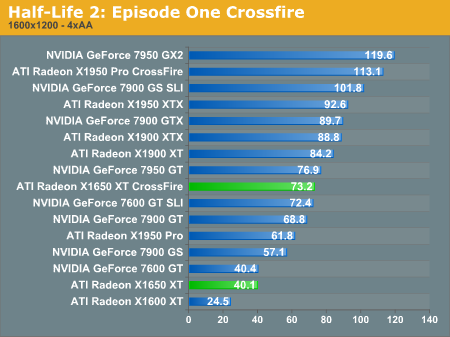
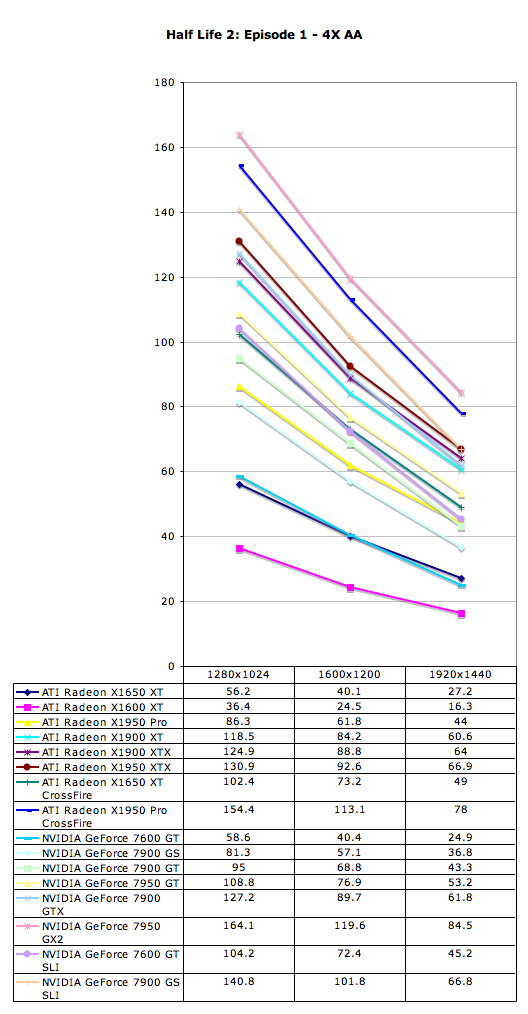
Here we see the 7600 GT SLI and X1650 XT CrossFire are back to being much closer to each other in performance (than with Oblivion) but this time the X1650 XT CrossFire gets a little better performance than the 7600 GT in the two higher resolutions; 1600x1200 and 1920x1440. Again we see that the performance of the X1650 XT in CrossFire mode is very similar to the X1950 Pro, and consequently, the latter card might be a better option that buying two X1650 XT cards to run in CrossFire.
CrossFire is something we wanted to look at for this launch, but generally speaking, it won't be a very practical option for use with this card. CrossFire requires a motherboard with two PCIe X16 slots which tends to be pricey, so if you are in the market for a system that is capable of this, you most likely aren't looking to get two cards of the performance of an X1650 XT; more likely you are looking to get the biggest and best. The performance of two cheaper cards in CrossFire or SLI operation is usually about equal to the performance of what it would cost to get a single faster card at the same price. Sure, it may look impressive, but it usually means more hardware, more power consumption, and more general headaches than you would get with a single card. Oblivion didn't have any performance anomalies with single GPUs, you will notice....
The X1650 XT is the second card with the new ATI CrossFire features. With the X1950 Pro, ATI got rid of the annoying dongle connector for good, and they have adopted a very NVIDIA-like approach, with small bridge connections on the top of the cards for CrossFire operation. We think this was a wise choice for ATI and applaud them for it.
We were curious what kind of CrossFire performance we would see with the Radeon X1650 XT, particularly in comparison with the GeForce 7600 GT in SLI mode. Again, since the 7600 GT is the X1650 XT's main competitor, how these cards perform in CrossFire and SLI was something we wanted to take a look at. We've also included some other cards for reference, and we've chosen a few of the same tests from our performance section for comparison.
CrossFire Performance Battlefield 2
The first test is in Battlefield 2 with 4X AA enabled.


In Battlefield 2, we see that with CrossFire we get a 55%-59% improvement in frame rate with the X1650 XT over single card operation. The performance of two of these cards in CrossFire (in this game) is comparable to a single X1950 Pro (or a 7900 GT or 7950 GT on the NVIDIA side). We can also see that the 7600 GT SLI gets slightly better performance than the X1650 XT in each of the resolutions. This is something we've seen in the past: in many instances, SLI provides better performance scaling than CrossFire. Here the 7600 GT SLI configuration performs 80%-90% better. Hopefully ATI can improve the efficiency of CrossFire more in the future.
CrossFire Performance Oblivion
For our Oblivion CrossFire tests, we again used 1024x768, 1280x1024, and 1600x1200, omitting 1920x1440 because most cards can't run the game at this resolution.


We noticed an issue during our Oblivion SLI and CrossFire tests with the 7600 GT in SLI mode. There appears to be only a very tiny increase in performance when running two of these cards in SLI mode over a single 7600 GT. We aren't exactly sure why this is, but Oblivion is definitely a very graphically demanding game, and ATI hardware tends to perform better with this game. This fact is very evident when we look at the kind of increase we see in performance on the graph above with the X1650 XT in CrossFire mode over a single card. At 1600x1200 we see about a 68% increase in performance with the CrossFire X1650 XT setup over the single X1650 XT. Having two of these cards in CrossFire mode will definitely allow you to crank up the settings in the game more, if you plan to go that route.
For now, we would disregard 7600 GT SLI performance in Oblivion as there appears to be a driver glitch at play. 7900 GS SLI scores 83%-88% higher than a single 7900 GS, so the <10% improvement seen on the 7600 GT SLI cards is clearly incorrect. We are investigating the matter further. X1650 XT will likely fall slightly behind 7600 GT SLI if we see a similar SLI improvement, however, as CrossFire only improves X1650 XT performance 62%-75% and the single X1650 XT is basically tied with a single 7600 GT.
CrossFire Performance Half-Life 2 Episode one
Lastly, we looked at Half-Life 2 Episode one with 4xaa enabled.


Here we see the 7600 GT SLI and X1650 XT CrossFire are back to being much closer to each other in performance (than with Oblivion) but this time the X1650 XT CrossFire gets a little better performance than the 7600 GT in the two higher resolutions; 1600x1200 and 1920x1440. Again we see that the performance of the X1650 XT in CrossFire mode is very similar to the X1950 Pro, and consequently, the latter card might be a better option that buying two X1650 XT cards to run in CrossFire.
CrossFire is something we wanted to look at for this launch, but generally speaking, it won't be a very practical option for use with this card. CrossFire requires a motherboard with two PCIe X16 slots which tends to be pricey, so if you are in the market for a system that is capable of this, you most likely aren't looking to get two cards of the performance of an X1650 XT; more likely you are looking to get the biggest and best. The performance of two cheaper cards in CrossFire or SLI operation is usually about equal to the performance of what it would cost to get a single faster card at the same price. Sure, it may look impressive, but it usually means more hardware, more power consumption, and more general headaches than you would get with a single card. Oblivion didn't have any performance anomalies with single GPUs, you will notice....










33 Comments
View All Comments
guidryp - Thursday, November 2, 2006 - link
They spec like this:1650XT: 8 vertex Pipes, 24 pixel pipes, 8 Raster pipes, 575MHz, Mem 675MHz X 128 bus.
7600GT: 5 vertex Pipes, 12 pixel pipes, 8 Raster pipes 560MHz, Mem 700MHz X 128 bus.
And the ATI card barely holds it's own? I was expecting a walkaway after reading the specs.
coldpower27 - Saturday, November 4, 2006 - link
It should be 24 Pixel Shaders vs 12 Pixel Shaders.while both have 8 ROP's, it is probably the X1650 XT only has 8 TMU while the 7600 GT has 12 as both are half their flagship derivatives. Ignore vertex amounts those tpyically aren't half and don't contribute to much on the most part to performance it seems anyway.
X1900 XTX 48 Pixel Shaders, 16 Rasterization Operators, 650MHZ, Mem 775MHZ x 256 Bit Bus
7900 GTX 24 Pixel Shaders, 16 Rasterization Operators, 650MHZ, Mem 800MHZ x 256 Bit Bus
The X1900 XTX doesn't walkaway from the 7900 GTX on the whole either.
trinibwoy - Wednesday, November 1, 2006 - link
Do you guys do other testing that you comment on that is not represented by the graphs? The numbers show a 1 fps difference, yet you use terms like "significant" and "clearly beats". Maybe some median low fps numbers would help demonstrate what you're saying.soydeedo - Monday, October 30, 2006 - link
hey i know i can make an educated guess as to where the x1650xt would end up on q4 benches compared to nvidia's offerings, but i'm still curious why this game was not included in the testing? with quakewars around the corner i think people are still interested in doom 3 engine performance.johnsonx - Monday, October 30, 2006 - link
I suppose this name is part of ATI's general trend lately. It used to be that the XT moniker meant the same GPU with slightly higher clocks. Now it seems like the XT parts are a separate family. The X1300XT has nothing to do with the other X1300's (rather it's a rebadged X1600Pro), the X1900XT has more pipes than non-XT members of the X1900 family, and now the X1650XT has nothing to do with the rest of the X1600/1650 family.It all makes it a bit hard to choose.
Kougar - Monday, October 30, 2006 - link
On page 10 it is mentioned thatThis is completely going against the bar graphs, specifically the HL Episode One graph. The x1650XT got up and began walking away from the 7600GT without AA, but with AA it tripped and slide into place just behind the 7600GT. At resolutions below 1600by1200 it even began losing by a sizeable margin.
Josh Venning - Monday, October 30, 2006 - link
This paragraph has been tweaked a little bit. In HL2 Episode one the X1650 XT only does better than the 7600 GT at the highest resolution with AA enabled, but in Battlefield 2 it performs a little better over most of the resolutions.Cybercat - Monday, October 30, 2006 - link
How many vertex units does this thing have?JarredWalton - Monday, October 30, 2006 - link
See (updated) table on page 2: it has 8 vertex units, 24 pixel pipes, and 8 ROPs. Basically, lots more power than the X1600 XT. I would guess the pixel pipes are more like R580 pipes (i.e. more shader power, but not necessarily the same as an NVIDIA pixel pipeline in raw power).Cybercat - Monday, October 30, 2006 - link
Alright, cool. I keep a chart with stats of graphics cards, so I'm just making sure I have the vertice throughput correct. Other than the useless X1650 Pro, ATI seems to have a much more competitive mainstream line now. There is now more confusion than ever, though.